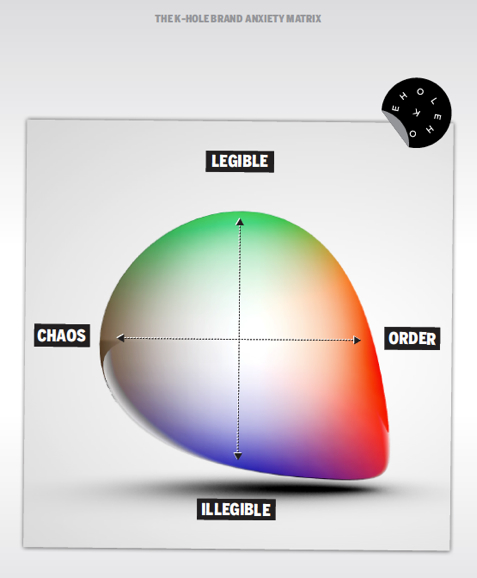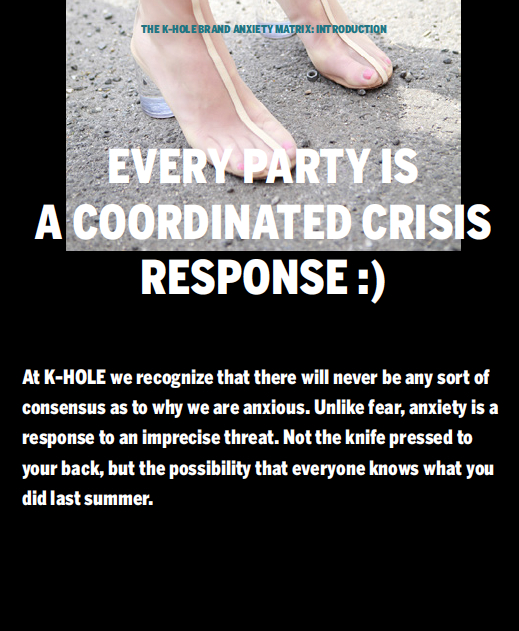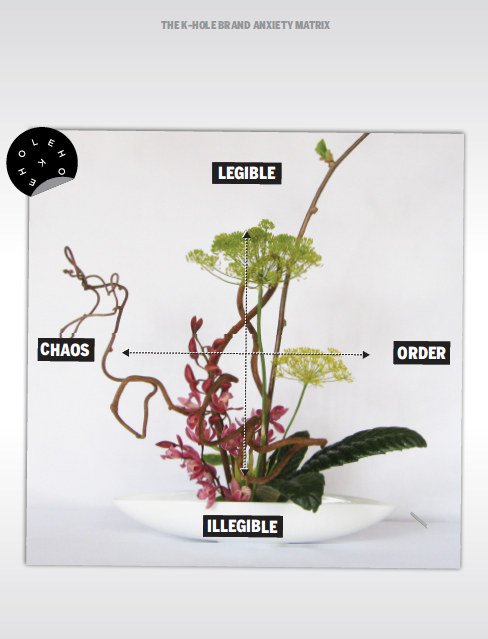
“Determinism would gain credibility if it gave us useful forecasts” wrote Gilles Dauvé and Karl Nesic, referring to those who saw the outcome of political events as written in their formation. Perhaps the same could be said of trend forecasts. What are they for, and why do people keep writing them? They’re certainly not very effective at predicting trends, yet their recurrence and popularity[1] within the art world over the past 5 years suggests they’re an increasingly important phenomenon in the development of post-internet culture. Unlike forecasts commissioned within marketing organisations, trend forecasts produced within the contemporary art world are nominally produced for public consumption; they act somewhere between an art object and a form of cultural criticism.
Among the pioneers of this form of trend forecast are K-Hole, a New York based crew who recently released their third forecast, a 49-page free-to-download PDF entitled THE K-HOLE BRAND ANXIETY MATRIX. It continues the aesthetic that has marked out K-Hole’s previous forecasts – sharp focus, minimalist stock photography, blocky capitalised typefaces and crisp infographics punctuate their trademark prose, a commercially-aware rhetoric that seems punchy, without ever really landing a punch.
Each forecast revolves around a central theme, an attempt to build a new conceptual model for brand awareness or technological innovation. Synthesis is the name of the game for K-Hole: every issue introduces a string of portmanteaus that successfully walk the fine line between blunt parody and genuine identification. ProLASTination, FragMOREtation, FLATmentation: this is the lexicon of dickheads, yet the carefully produced portfolio of case studies that make up the bulk of each document build each tongue-in-cheek neologism into a more thoughtful model for understanding cultural phenomena and fluid consumer subjectivities as they exist today. The level of cultural literacy and critical engagement with their audience separates the trend forecast produced within the context of contemporary art from the trend forecast produced for the boardroom suits: these are texts which speak to the demographic they analyse, rather than simplify these demographics for paying clients. It’s this difference, this understanding of spectatorship, that activates K-Hole’s PDFs as a hybrid form of art-object and cultural criticism. Paradoxically, however, it’s also this cultural fluency with the target demographic that makes it catnip to smart marketing teams, and it’s this duality which creates an ethical tension within the format that is perhaps an echo of the wider crisis of form that both haunts and drives the world of post-internet cultural production. Whilst the content is interesting, it’s the evolution and reproduction of the form, straddled between the critical and the commercial, that really highlights what is vital and problematic in this phenomena.
K-Hole’s third edition seems to elucidate far more clearly this tension, making the development of cognitive models the main focus of the document and moving away from predictive scenarios. Whereas earlier forecasts offered potential new configurations of existing technologies or products, Issue 3 instead offers a more explicit model for understanding the relationship between potential future everyday technologies and our everyday lives, in the form of a matrix which examines risk assessment.
This is perhaps the key to understanding the reasons why trend forecasting has taken off within the post-internet demographic. The trend forecast represents a displaced subject: rather than being predictive or even speculative visions of what is to come, they actually function as models to conceptualise and contextualise the effects a technological explosion is having upon our everyday lives. The latest K-Hole report hits the nail on the head: the relationship between the demographic and the trend forecast is one of managing anxiety precipitated by the pervasive technology of the internet revolution. Rather than thinking of trend forecasts as commercial documents (or simulations thereof), we should examine them as creative texts which are trying to contextualise and understand that revolution, in a similar vein to science fiction. Rather than science fiction, trend forecasts effectively function as consumer fiction.[2]

Science fiction emerged as a creative field primarily as an entertainment form, but as the field evolved it quickly came to be seen as something more — a way to understand the deep and significant technological change which revolutionised everyday life in the 19th and 20th Centuries. Automation, the shrinking of space through faster transport and communications, and the development of the massified workers subjectivity under a state model — all these technological changes were profoundly political, and science fiction emerged as a popular and accessible cultural form in which to discuss and understand often terrifyingly fast social change. The worlds of science and technology held the obvious language to utilise — it seemed to be machines that were changing our world: vast industrial machines enabled by state power, by huge actors, to drive deep into the earth, to reach new planets, to reconfigure a society in its entirety.
Today we’re in the opening stage of a similarly enormous technological revolution. The social fabric is being torn and reconfigured by massive infrastructural developments. Changes in capitalist development are likewise revolutionising the everyday lives of working people. In the developed world the age of the mass worker, and its coterminous subjectivity, is being eroded into a new subjectivity — the post-fordist worker. This worker is not defined by the production line but by precarious working conditions, outsourcing, self-employment and self-branding. The division between work and leisure time – produced by proletarianisation and formalised by the labour movement – is increasingly a meaningless abstraction. New digital technologies as well as wider economic and political currents created by the crisis of capital in the late 1970’s – the destruction of labour unions, containerisation and cheap credit through financialisation – have combined to produce a new idea of the productive, creative individual (and the subjectivity of the post-fordist worker is by its very nature individual). Whilst contemporary art attempted to come to terms with the collapse of socialist project in the 1990’s, most notably through relational aesthetics, the post-internet tendency seems to be tackling a much wider change in technology, work and production in a way unseen since Warhol took on consumer capitalism in the early 1960s.
And so what characterises a young, mid-crisis, post-internet productive subjectivity? In a word, anxiety. Uncertainty about our financial and professional futures as a result of the deferred crisis in capital, but more importantly, uncertainty about the future due to the rate of technological change we see happening around us. In dealing with this perfect storm of technological and economic factors, this unique point on the Kondratieff cycle, trend forecasts function as a creative response to anxiety and change. Rather than science fiction, trend forecasts are consumer fiction, imaginative responses to technological change which help us understand the present through speculative future scenarios, told within the dominant language of possibility – the brand.
It is working within the visual language, culture and organisational models of the corporate world which is beginning to characterise post-internet art. Just what is it that makes today’s corporations so appealing? Isn’t there a paradox here, whereby artists are attempting to emulate the organisational aesthetics of corporations at the same time as those very corporations are beginning to take notice of the decentralised, networked aesthetics, and the shift in the role of consumer and spectator, reflected within post-internet art? Perhaps, but the tendency of thinking within the discourse of the brand is understandable. In his influential and engaging short book Capitalist Realism, cultural theorist Mark Fisher clearly defines the environment in which this tendency emerged and now dominates; an environment where political antagonism has given way to managerialism, and where contestation is subsumed into a post-ideological framework of individual success or failure. ‘Capitalist Realism’ is the ideology that now structures our world, the idea that, in the words of Margaret Thatcher, there is no alternative. Neo-liberal capitalism seamlessly occupies the horizons of the thinkable. Within that framework, what does the emulation of the creative visual forms of the corporation signify? What’s with post-internet artists and all their corporate swag?[3] Looked upon favourably, it suggests an ambition for the work. The visual language of the corporation is the language of the possible. Who structures our visual environment on a daily basis, but advertising agencies working on behalf of corporations?
The move towards brand language marks a desire to engage with the visual cultures of daily life. In adopting the form of the commercial policy document, artists are shifting the context of their work back to some form of social engagement, and that’s a tacit admission of just how ineffective contemporary art discourse has been in making practical and pragmatic interventions into the real world of everyday life. Instead, the utilisation of the language of the commercial sphere, then, signifies a genuinely radical shift from the forms of post-socialist contemporary art that came before, in the form of Relational Aesthetics — an attempt or desire to produce art that engages with everyday life, which changes the social or political world it is produced in. We can lament that there is no other political framework in which radical social engagement can occur, but we cannot really deny it.

There is, of course, another key aspect to the development of trend forecasts within the language of the commercial – namely, the moving of artistic practice in post-internet art into a form that can be monetized. This is the ‘crisis of the form’ that has been the primary concern of post-internet art from its very moment of self-realisation. The question posed is how much the work deals with immateriality as a critical concern, and how much the artist is forced to change or direct their practice as a result of the very real material concerns – the ability to reproduce their life and practice. Let’s make this clear – the primary concern of post-internet art is still “how can you represent if you can’t pay the rent?”[4]
The adoption, then, of forms of presentation and display taken from the cutting edge of marketing seems to be an ongoing concern of post-internet practice, as reflected in K-Hole’s work. Where relational aesthetics was an attempt to build a socially-engaged practice in a post-socialist context (within the ideological and practical constraints of market distribution models), post-internet art appears to adopt the constraints of marketing as an inspiration if not an aspiration. Charitably we can see this as a reaction to the creative revolution digital technology has started; an attempt to create a new consumer fiction genre aimed at processing and critically questioning the enormous changes that digital technology is effecting in our everyday lives.
The crisis in this approach should be clear, however. Is the tendency to re-enact or inhabit the systems of sociality, social or cultural reproduction not just a massive failure of the collective imagination to reach beyond those inherited structures in the first place? If we see the internet as an endeavour of the general intellect to break out of the limits of social and cultural reproduction put upon us by capital – of intellectual property, privatisation of knowledge and culture etc – this tendency represents the recolonisation of those infinite territories by consumer forms. Post-internet art is in danger of presenting itself as a tool of limitations, a rappel a l’ordre, a call to return to the traditional forms of cultural and artistic production that characterised the post-modern era, rather than a creative form worthy of critically engaging with the platform and people who created it.
Huw Lemmey is a writer and artist based in London. He works in marketing for Verso Books. He writes online under the name Spitzenprodukte.
[1] Two good examples of this tendency are Recreational Data’s Currency Zones of the Future and Deterritorial Support Group’s Ten Growth Markets for Crisis.
[2] Perhaps these can be seen as a counterpoint to “design fiction”as imagined by Bruce Sterling; however, Sterling’s genre can be seen as a way to creatively map out potential future technologies rather than as a way to cope with and understand the implications of contemporary technology.
[3] Overheard in the Limazulu kitchen
[4] https://youtube.com/watch?v=NFNhWOT9hTg